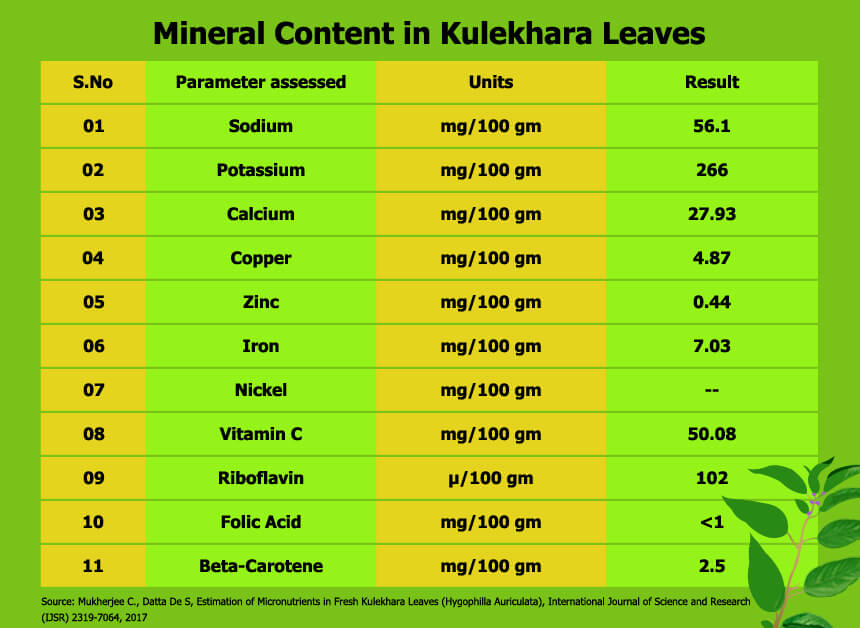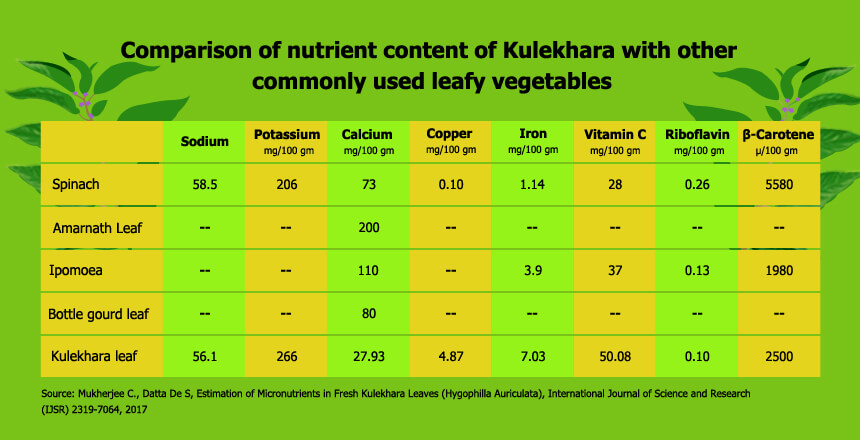Kulekhara: The Wonder Herb for Nutritional Security
Kulekhara herb is a missed opportunity for bringing in nutrition security to the poorest and the marginalized. Kulekhara grows in the wild in most parts of the country and is a very hardy plant. However, despite its easy availability and high nutritional value, Kulekhara remains unknown and unheralded to the majority of Indians despite its potential. It’s almost akin to relegating Einstein to teach mathematics in a primary school.
Kulekhara or, Hygrophila auriculata is known by local names; In Bengali, it is called kulekhara, In Sanskrit Ikshugandha, Kokilaksha and in Hindi Talimakhana. It is a spiny bush and is common throughout India. Though the whole plant has been used medicinally root & leaves are used more. Ayurveda texts cite its efficacy in skin diseases, dropsy, and sleeplessness. It is found useful against renal stones too. The plant is used as a demulcent, aphrodisiac, diuretic, urinary tonic and hepatoprotective substance. Its biggest claim to fame is using for increasing Haemoglobin in blood.
A.Gomes et al. (2001) studied the effect of ethanolic extract of Kulekhara leaves on male albino rats. The result of this study showed the significantly increased of hemoglobin, hematocrit, RBC and total WBC counts and the Total Iron Binding Capacity in male albino anemic rats.
Mukherjee and Dutta De (2017) in a seminal piece of work studied the mineral content in Kulekhara leaves. These results confirm Kulekhara’s pre-eminent position as high on nutrition levels.
 When we compare Kulekhara with other more popular leafy herbs like spinach, Ipomoea, bottle gourd and amaranth leaf, Kulekhara emerges as a clear winner on many counts. A comparison of the mineral nutrient content of Kulekhara as compared to other herbs is given below:
When we compare Kulekhara with other more popular leafy herbs like spinach, Ipomoea, bottle gourd and amaranth leaf, Kulekhara emerges as a clear winner on many counts. A comparison of the mineral nutrient content of Kulekhara as compared to other herbs is given below:
 Spinach is a household food item with many recipes based on Spinach being available. However, Kulekhara in many of the nutrient content is better than Spinach. For iron, copper and vitamin C, Kulekhara beats Spinach hands down. Unfortunately, Kulekhara has not achieved the required importance in the kitchen of Indian households to the extent Spinach has.
Spinach is a household food item with many recipes based on Spinach being available. However, Kulekhara in many of the nutrient content is better than Spinach. For iron, copper and vitamin C, Kulekhara beats Spinach hands down. Unfortunately, Kulekhara has not achieved the required importance in the kitchen of Indian households to the extent Spinach has.
We at Branolia strongly believe that including Kulekhara in the midday meals of schools and Anganwadi (ICDS) centers across the country may be seriously considered. It grows everywhere, it is cheap and it is a great source of micronutrients, which is required for brain development in the growing years of children.
Branolia’s Kulerron packs the goodness of Kulekhara leaves and root, to bring to you not only micronutrients of the leaves but nutrients found in the Kulekhara root including alkaloid, Phytosterol, Potassium Salt of Oxalic Acid, Diastase, Protease and Essential Oil.
Kulerron is the only formulation available in the market which packs the richness of Kulekhara. We remain a committed soldier in the fight of the nation against iron and micronutrient deficiency.
Reference:
Gomes, Manika Das & S.C Dasgupta “ Haemanitic effect of hydrophilic spinasa T, Anderson on experimental rodents” Indian Journal of Experimental Biology Vol. 39, April 2001, pp. 381-382
Mukherjee C., Datta De S, Estimation of Micronutrients in Fresh Kulekhara Leaves (Hygophilla Auriculata), International Journal of Science and Research (IJSR) 2319-7064, 2017
[supsystic-social-sharing id="1"]

Where can I buy this kulkhekra syrup in Bangalore?
You may order online at https://www.branoliachemicals.com/buy-now/
You can place an order over the phone
(10:00 AM – 6:00 PM) at:
+91 – 9831014169
+91 – 6290803103
+91 – 9836416392
You may email your order at branolia.chem@gmail.com